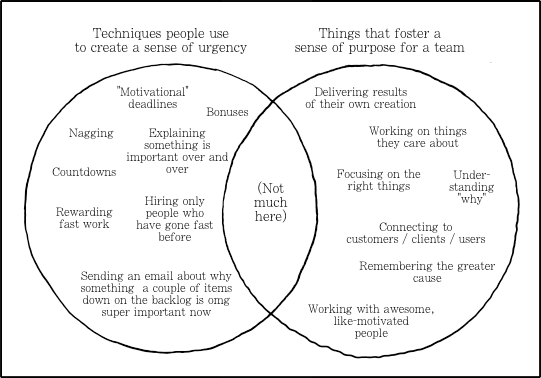"Your team should only be as big as can be fed by two pizzas" is a popular saying in entrepreneurship circles. This usually comes down to about four or five people. Teams bigger than this will begin to raise management problems that delve into the domain of the Venn diagram above.
A startup at it's very early stages when it has a handful of employees is in it's most productive phase, where tangible progress is made every other day. This is because the founders and the initial employees are always aligned. They are working towards the same end goal and with the same sense of purpose in mind. There is no intersection with the circle on the left in the Venn diagram. If there is, then that startup is bound to fail even before it takes off.
But, as the team begins to grow upon the initial successes, the number of people begin to increase and they can no longer be fed by two pizzas. When the team size goes into the tens of people, it gets exponentially harder to have all of them be driven by the same end goal and the same sense of purpose. This is where things like ESOPs come into picture, to ensure that the growing number of people are all aligned together by the potential of financial rewards for moving in the same direction.
This is the stage where the circle on the right begins to intersect with the circle on the left. Although there is little in common between them, some people prefer to drive their teams to perform through incentives (or dis-incentives) that fall in the circle on the left and some continue to drive their teams through incentives that fall in the circle on the right. It is easier to manage teams by creating a sense of urgency than by creating a sense of purpose. Especially so when the teams are larger than what can be fed by two pizzas, as the intersections in what they are passionate about becomes smaller and smaller.
If you have been part of a growing company, you would have heard about the need to bring in "processes". The "processes" are all things that fall into the circle on the left. Nobody ever created a sense of purpose in their team by setting up a process.
Even with small teams, although a sense of purpose can be created for the work they are responsible for, no team works in isolation. And when multiple such teams have to work together, there is again a breakdown of a sense of purpose since what is isolated to one team may not be applicable to the other teams that it has to work with. And managers default to setting up "processes" in such scenarios.
Although I don't have a clear solution for this, I do believe that driving teams through a sense of urgency as opposed to driving them through a shared sense of purpose is a recipe for disaster. This is the appeal of startups over bigger companies today for those who have a choice between them for deciding where to work.
How has your experience been in managing such teams?





CONVERSATION